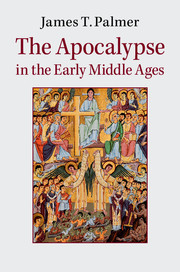Book contents
- Frontmatter
- Dedication
- Contents
- List of figures
- List of maps
- Acknowledgements
- List of abbreviations
- Maps
- Introduction
- 1 The end of civilisation (c. 380–c. 575)
- 2 The new urgency (c. 550–c. 604)
- 3 The ends of time and space (c. 600–c. 735)
- 4 Pseudo-Methodius and the problem of evil (c. 680–c. 800)
- 5 Charlemagne, pater Europae (c. 750–c. 820)
- 6 A Golden Age in danger (c. 820–c. 911)
- 7 The Year 1000 and other apocalypticisms (c. 911–c. 1033)
- Conclusion
- Select bibliography
- Index of manuscript references
- General index
- References
6 - A Golden Age in danger (c. 820–c. 911)
Published online by Cambridge University Press: 05 November 2014
- Frontmatter
- Dedication
- Contents
- List of figures
- List of maps
- Acknowledgements
- List of abbreviations
- Maps
- Introduction
- 1 The end of civilisation (c. 380–c. 575)
- 2 The new urgency (c. 550–c. 604)
- 3 The ends of time and space (c. 600–c. 735)
- 4 Pseudo-Methodius and the problem of evil (c. 680–c. 800)
- 5 Charlemagne, pater Europae (c. 750–c. 820)
- 6 A Golden Age in danger (c. 820–c. 911)
- 7 The Year 1000 and other apocalypticisms (c. 911–c. 1033)
- Conclusion
- Select bibliography
- Index of manuscript references
- General index
- References
Summary
Charlemagne had left a deep legacy for the coming generations. Writing for the emperor’s great-grandson Charles the Fat sometime between 885 and 887, Notker the Stammerer of St Gall proclaimed that:
The omnipotent disposer of all things and the director of kingdoms and of the ages, when he had destroyed that wonderful statue with feet of iron or clay among the Romans, set up the golden head of another no less remarkable statue among the Franks through the illustrious Charlemagne.
Toying with the Danielian scheme of world kingdoms, Notker had cast the Frankish empire as the ‘kingdom which shall never be destroyed’ (Dan. 2.44) – or at least which would never be scattered. Notker, of course, knew that the Carolingian Empire had often been carved up since Charlemagne’s death in 814 but in the new Charles, the third of that name, the empire had a new uniting power. Or at least it would have if Charles could learn the lessons of his predecessors. As Paul Dutton once argued, the ninth century was a time in which people could feel the breathless pace of change acutely – and that was without taking account of the obliteration of political organisation in nearby England at the hands of the Vikings in the 860s, where no doubt change was felt no less acutely. There were new enemies and new heresies, but these were accompanied by new heights of creativity and cultural production. Charles had every advantage as well as challenges he could turn to his benefit. Within a couple of years of Notker’s writing, however, the Carolingian Empire was emperor-less and seemingly in decline. Daniel’s scheme was running out of incarnations.
- Type
- Chapter
- Information
- The Apocalypse in the Early Middle Ages , pp. 159 - 188Publisher: Cambridge University PressPrint publication year: 2014



